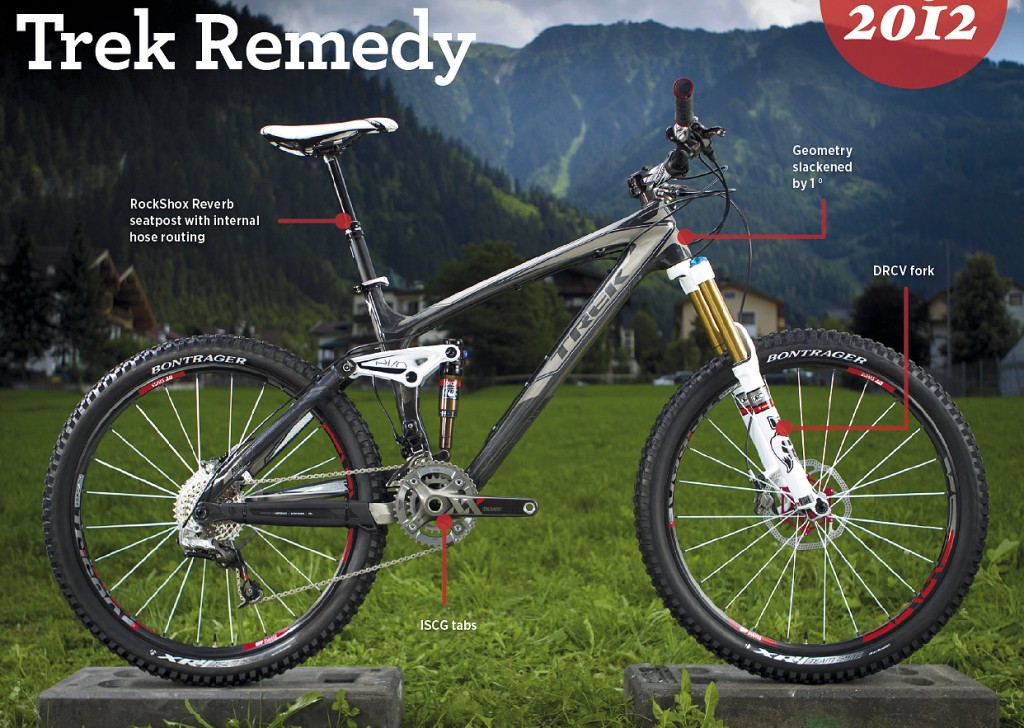Click here to read the full review of the Remedy 9.8.
We’re just back from Trek’s 2012 launch in Mayrhofen, Austria. While the rest of the world’s media were drooling over the all new carbon Session 9.9, as ridden by Aaron Gwin and Tracey Mosely on the World Cup this season, we were more taken with the revised 150mm Remedy.
For 2012 Trek has managed to squeeze its DRCV shock tech into a Fox Float fork. That means that rather than one air chamber, it has two, with the second, supplementary chamber being activated as the fork (and indeed the shock) moves through its travel.
What that means on the trail is a more linear feel than a standard air fork, and one that mates better to the DRCV shock Trek has been using at the back for the last three seasons.
Most excitingly for us, most of the gripes we’ve had with 150mm bikes across the board — too steep headangles, and missing ISCG tabs — have been addressed.
For 2012 Trek has taken a degree off the headangle (slackening it to a confidence inspiring 67deg) and added ISCG tabs, so if you want to run a two rings and a chain device, you can. The market demanded it, and Trek stepped up, even on its (incredibly) lightweight carbon Remedies such as the 9.9 we got to ride in Austria.
If that slacker geometry sounds too much for your tastes, don’t worry: thanks to the new Mino link on the rear of the rocker link, you can raise the BB and steepen the headangle by half a degree.
Trek was also excited to show off its new Reverb Stealth seatpost. Essentially, this means the Reverb’s hydraulic hose no longer attaches to the seatpost at the top of the post, but at the bottom, which requires the hose to run through the seat tube. It stops the hose bulging out when you drop the saddle, rubbing against your leg or buzzing your rear tyre, so it’s a nice touch that makes a bigger difference than you’d perhaps expect.
We got to ride the remedy on some amazing old hiking and bike park trails around Mayrhofen in Austria (see the video). With its dropper post, slackened headangle, short stem and 720mm carbon bars the Remedy feels ready to rumble as soon as you get riding. The trails were highly technical, with roots, rocks, steps and switchbacks in abundance, and yet despite riding the trails for the first time, we felt confident to let the bike run without worrying we were going to get into (too much) trouble.
But don’t let us fool you into thinking the Remedy is all about the downhills; it’s no slouch on the climbs either. Another running change for 2012 is a three position switch on the Fox DRCV shock so that you now flick the compression from off (for the descents), to central (low, for rolling singletrack) to far right (as you look at it from above in a riding position), which is maximum compression for the climbs.
With the top end bike we rode being so light, we felt like we were climbing pretty fast — it will be interesting to see how the more “everyman” incarnations of the Remedy feel on the ups in comparison.
At the time of writing there is no word on pricing, but hopefully by the time we bring you news of the rest of the 2012 Trek range in the September 2012 issue of MBR, we’ll have some idea of cost. Be sure to check it out — there are some VERY exciting new bikes in the line-up!





